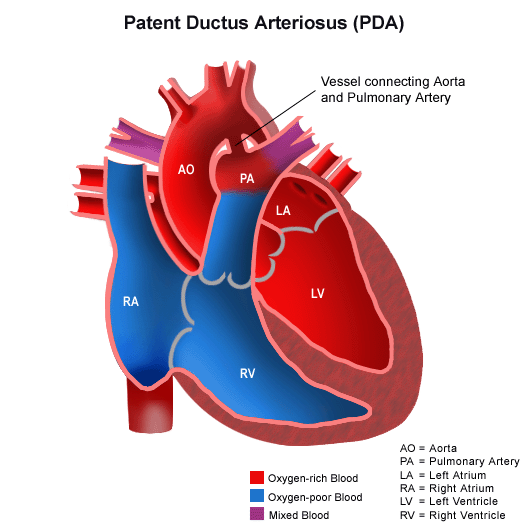Patent Ductus Arteriosus (PDA)
 PDA results from persistent patency of the fetal ductus arteriosus, which is necessary during fetal circulation to divert deoxygenated blood from the PA to the descending aorta, away from the unventilated pulmonary vasculature. After birth, the shunt becomes left-to-right and under normal conditions is completely closed in the first 2-3 weeks of life. PDA is common in premature infants with low birth weight. Dr Robert Gross first performed surgical closure of PDA in the 1938 and is regarded as a pioneer in the field, being one of the first to attempt surgery on the major vessels in a neonate.
PDA results from persistent patency of the fetal ductus arteriosus, which is necessary during fetal circulation to divert deoxygenated blood from the PA to the descending aorta, away from the unventilated pulmonary vasculature. After birth, the shunt becomes left-to-right and under normal conditions is completely closed in the first 2-3 weeks of life. PDA is common in premature infants with low birth weight. Dr Robert Gross first performed surgical closure of PDA in the 1938 and is regarded as a pioneer in the field, being one of the first to attempt surgery on the major vessels in a neonate.
Symptoms vary from asymptomatic to findings of heart failure and increased incidence of respiratory infections, depending on the amount of shunting. A continuous “machinery” murmur is present and the CXR may show an enlarged heart and increased pulmonary vascular markings. Diagnosis is confirmed by echocardiography, which can also be used to determine the size of the duct and estimate the degree of shunting.
Closure is indicated for all isolated PDAs to eliminate heart failure, prevent pulmonary hypertension, and avoid endocarditis. Medical closure with indomethacin or ibuprofen is usually effective in neonates. Surgical ligation or division of the PDA is indicated in neonates for failure of medical treatment, contraindications to indomethacin treatment, and for infants with necrotizing enterocolitis. The approach is through left thoracotomy incision. Complications of surgery include recurrent laryngeal nerve injury, phrenic nerve injury, and chylothorax. Transcatheter closure has gained acceptance in older infants and many devices are available.
